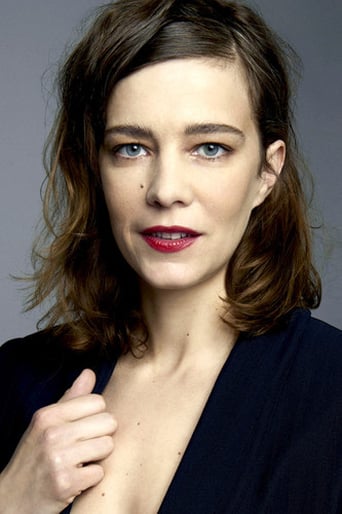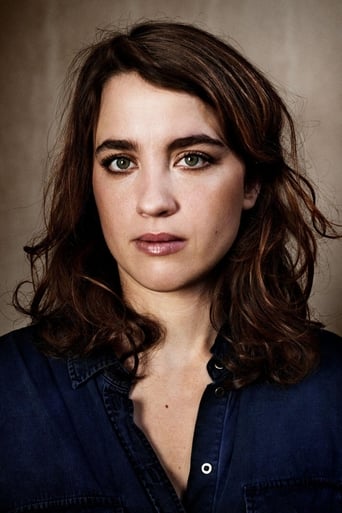GurlyIamBeach
Instant Favorite.
Smartorhypo
Highly Overrated But Still Good
WillSushyMedia
This movie was so-so. It had it's moments, but wasn't the greatest.
Griff Lees
Very good movie overall, highly recommended. Most of the negative reviews don't have any merit and are all pollitically based. Give this movie a chance at least, and it might give you a different perspective.
maurice_84
This film is physically gorgeous and the content is hideous. Some reviews here have said that the nudity of the women is "boring" (because it is not used to provoke the audience's sexual response, but rather to reinforce the women's place as "objects"?) and another found the film soporific because of its slow pace, repeated images, and lack of "action." What was needed? A carriage chase (since car chases wouldn't have been possible), or perhaps a daring robbery? In fact,the slow pace of the film reiterates the slow death of the women. The fact that some of the reviewers complain that the film doesn't contextualize the story enough only speaks to our general lack of education about history or the world beyond our own i-pods and pads. Only in the 20th century do most women begin to achieve "rights" and freedoms (and at great cost). And that century is only beginning at the end of this film. For that matter, the film's ending--in contemporary Paris at the historic site of the brothel--implies that those rights and freedoms are easily erased for some.For those who want more action (slashing someone's face is apparently not enough), this film will disappoint. For anyone who is interested in the history of the era and this aspect of Parisian (and European) life, it's a must see. All the slow scenes in the brothel with "gentlemen" clients and prostitutes are framed during the same period as the Dreyfus case, the beginning of the decline of French power and prestige. This film shows the darker side of much that is revealed in Proust's work (which is, after all, rather dark itself). It is definitely a disturbing film, but worth seeing.The women actors works wonderfully together, and the production values are impressive.
TdSmth5
If you absolutely have got to know what life might have been like for prostitutes in Paris during the early 1900s then you've got to see this. For everyone else, there's nothing here to see.L'Apollonide is a classy palatial bordello. The prostitutes live and work there. They are under the soft yoke of the madam who sells them everything they need for a hefty price such that they are forever indebted to her and for some reason can't leave. We learn all the boring details of what their life is like- their hygiene routines, their exams with the physician, what they do to pass the time (not much). On some days, there are a bunch of children there. At night the clients arrive, and still little happens as they are happy to just sit around with the prostitutes and stare at each other, play board games, flirt, gossip. One of them brings a panther with him for some reason- a panther that doesn't age. When they get down to business it turns out all the clients have kinkyish proclivities.One of the prostitutes who has nightmares and visions actually ends up fulfilling them as one of her clients slashes her cheeks, making her unsuitable for regular work. Another ends up with syphilis and dies. We also meet a young girl who decides to join the staff, with the blessing of her parents somehow. The life is portrayed as a type of slavery and yet women join it voluntarily as way out? And the panther will deliver justice. The bordello also faces closure eventually. That is about it when it comes to a plot. The writer/director does his best to avoid telling a story. For instance, one of the girls will read the tarot cards to the others to answer questions. She interprets the past, the present, and when she gets to the future, the director cuts to something else. When there is action, it is almost filmed in slow motion, everybody moves with all the patience in the world in a calculated unnatural way, as if the actors are being overdirected.The movie looks pretty good, the longest and most commonly repeated scene of the prostitutes sitting around with clients looks like a living still life. Music and sounds are OK until we get near the end when suddenly we get loud anachronistic contemporary music. This movie is 2 hours long but it feels like 20 hours. I had to see it in two sessions.What is the point of the movie one asks oneself after sitting through this sedative? Other than being the writer/director's prostitute-adoration piece I can't think of any. It doesn't glorify prostitution but it doesn't humanize it either. One can't care for any of the prostitutes, they all look fairly alike and are not particularly attractive, let alone interesting. It doesn't vilify or humanize the clients either. The emotional tone of the movie is entirely flat throughout. One fears there is some brilliant message that one missed but after watching the behind-the-scenes feature where the director explains himself one can conclude that nothing was missed, there isn't anything to this movie. Somewhere hidden behind endless repeated scenes where nothing happens could have been a decent movie about the life and dreams of prostitutes during those Parisian times. But the director isn't interested in telling a story, he is obsessed with some images that he repeats in all his movies and that derail what could have been a story. If anything, this movie is a remarkable waste of effort, funds, and talent, and a lesson on how not to make a movie.
writers_reign
It's difficult to determine the target audience for this entry, if indeed there is one. There is one short scene involving full frontal nudity but this involves an applicant for a job in the brothel displaying her body for the madam so that there is no erotic content whatsoever. Elsewhere there are liberal helpings of naked breasts but again with a palpable lack of eroticism so we can rule out the dirty mac brigade. Bonello - who has something of a penchant for making films with a sexual content - Tiresia, The Pornographer - seems almost to be making a documentary recording life in a maison close during the years 1899-1900. This was, of course, the era known as the Belle Epoque but instead of rich, sumptuous colours, Bonello gives us muted, even drab colour photography and perversely shows us a girl with a tattoo - in 1899? - and introduces raucous rock music which clashes totally with the mood which verges on the serene - clearly Baz Luhrmann has a lot to answer for. With the exception of Moemie Chomsvsky, herself a gifted director and fine actress, as the madam, the cast is more or less unknown and appear to have been selected on the basis that they have (presumably) 19th century faces. By definition anyone who actually remembered the year 1899 would be around 120 today so there is no one to say Bonello hasn't got it right which still leaves the question, why bother.
genet-1
"House of Tolerance" opens with a scene that typifies the film. A gentlemanly client of L'Appollonide, the fictional Paris brothel of the 1890s where the film is set, declines sex with the exotic and likable Madeleine, but requests she instead describe one of her dreams. After she recounts a fantasy of sex with a masked man that ends with her weeping tears of semen, he politely asks permission to tie her to the bed. One she's helpless, he slashes both her cheeks with a knife,leaving her with a permanently disfiguring grin.In a real-life Paris bordello like Le Chabanais, the establishment that inspired L'Appollonide, Madeleine would have been turned out. Instead, the other prostitutes and its kindly madame, hearts of gold all, rally to protect her. She becomes the house's cook, minds the children, and even, as "The Woman who Laughs", continues to attract jaded aesthetes excited by deformity. In one of the film's more Sadeian scenes, she stars at an orgy involving aging aristocrats, a staff of female servants, all nude, and a sullen black-gowned dwarf. We see one of the obligatory fortnightly health checks required by the police, and the system of paying the women; clients buy tokens, which the women cash in at the end of the night. Such realism clashes with a Visconti-esque sumptuousness in costumes and decor. The house itself is palatial compared to Le Chabanais, or any real brothel, and the women more attractive than the habitués of even the most elegant establishment.The film often feels like an anthology, shuffling together episodes and individuals associated with the brothel culture, and not bothering too much about anachronisms. An idyllic country picnic and skinny-dip for the girls evokes the most humanizing of whorehouse stories, Maupassant's "Le Maison Tellier". A client, called only Gustave and content to spend his time in the brothel staring raptly at vaginas, suggests Gustave Courbet, who painted "The Origin of the World", a meticulous but faceless depiction of female pudenda. Courbet, however,died in 1877, well before the period of the film. Bonello is closer to his time period when he shows a girl being bathed in champagne. The then-Prince of Wales, Victoria's son and later Edward VII, liked to sit around such a bath at Le Chabanais and share the wine with friends. Wine, water and secretions mix promiscuously in the film. In an early scene, whores and clients share champagne from a gilded chamber pot of what should be Sevres porcelain but resembles anodized aluminum. Meanwhile, the girls play a table game using the squirt bulbs normally employed to flush their vaginas. Repeatedly we see women rinsing their mouths after oral sex and washing the sticky residue of wine from their bodies. One woman observes bitterly, "this place stinks of champagne and sperm." Bonello is at pains to insist on the moral and emotional superiority of the prostitutes over their sentimental, self-absorbed clients – something even the men concede. As one ruefully confesses, "men have secrets, but no mystery." Even Gustave, the most compassionate of the regulars, sees the women as objects. The complaisant Pauline dresses up for him, first in a Japanese kimono, then as a blank-eyed, jerkily moving doll. In a scene reminiscent of Donald Sutherland coupling with a clockwork woman in "Fellini Casanova", her impersonation of a machine excites Gustave in a way flesh and blood never did. As he penetrates her from behind, she stares expressionless at us, the audience, as if to ask, "How like you me now, my masters?" Returning repeatedly to the mutilation of Madeleine, adding more graphic detail each time, Bonello makes us complicit in her pain. Her endurance and acceptance, like that of all the prostitutes, is transcendental, and appears a kind of martyrdom – an offering to the Apollo for which the house is named. The girl dead of syphilis, the opium addict, and, finally, all the women dumped on the streets when the brothel closes down, have suffered and died for our sins. The last shot of the film drives home the point. Beside a modern highway, the same girls who staffed the L'Appollonide, now in mini-skirts and hot pants, continue to offer sex and salvation to an indifferent male world.





